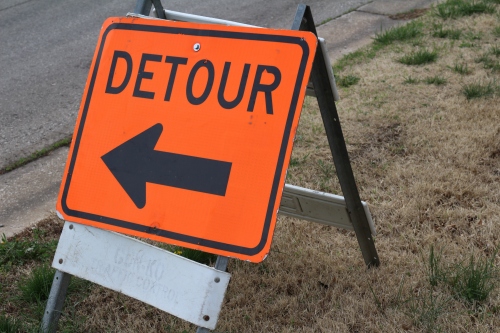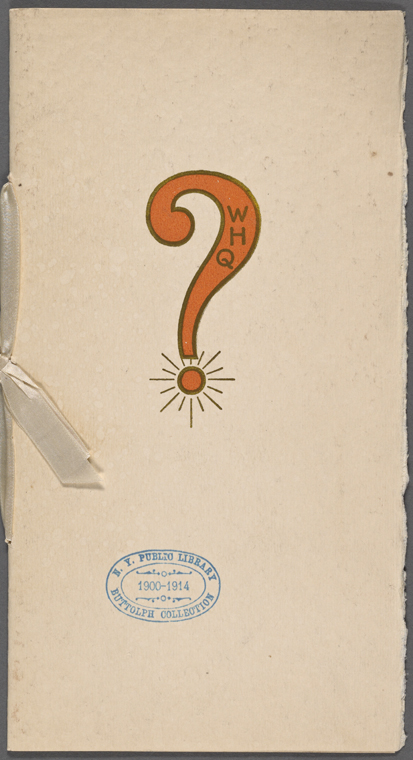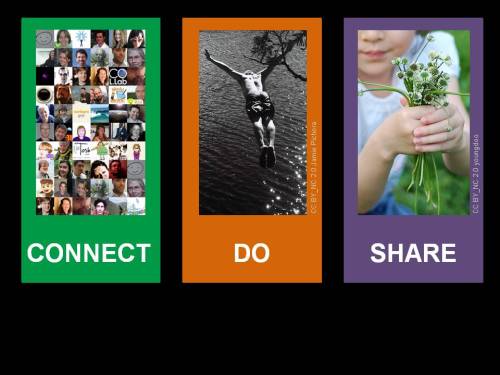The OER15 Open Education Conference held in Cardiff last week may be over, but the reflections, connections, and tweets (#oer15) are still simmering. For a flavour of the conference, excellent summary blog posts by Marieke Guy (Window boxes, battles, and bandwagons) and Grainne Conole (The OER15 conference) are well worth reading, as is Viv Rolfe’s post (with screencast): Open education: sustainability versus vulnerability and Sheila MacNeill’s account of her excellent keynote: Airing my open washing. The title of my session at OER15 was Navigating the boundary between formal and informal learning in higher education. Following are the slides and a short summary. I’d welcome your comments, either here in the blog, on Twitter (@catherinecronin), or in the Padlet I created to gather feedback during the session.
ccc
I’ve been a long-time advocate and practitioner of open education and now am engaged in PhD research in the area of open educational practices in higher education. Although the context of my current research is HE, I’m exploring learning beyond the bounds of the institution, focusing particularly on the boundary between formal and informal learning, and how educators and students navigate this boundary.
FORMAL & INFORMAL LEARNING
As networked individuals we continually engage in informal learning – any time, anywhere – based on our interests, our curiosity, and our passions. Through our informal learning practices we develop our own, necessarily personal, learning networks, communities, and identities. These networked and open practices often sit uneasily within formal education. As education professionals, many of us have found ways to integrate (to a greater or lesser extent) our open networked practices with our institutional roles. Bonnie Stewart has explored the complexities of this process in her recent PhD research:
… few scholars inhabit a solely digital, networked, or open educational sphere; many engage in networked scholarship while simultaneously working towards institutional academic goals and careers. This means navigating multiple sets of expectations and legitimacy standards at the same time, as well as negotiating institutional relationships with peers, superiors, and students for whom the participatory set of terms may be invisible or devalued. (Stewart, 2015)
But what about our students? How do students in higher education navigate these boundaries and complexities? Connected Learning is one approach that focuses on fusing informal and formal learning practices.
Connected Learning is a model of learning that holds out the possibility of reimagining the experience of education in the information age. It draws on the power of today’s technology to fuse young people’s interests, friendships, and academic achievement through experiences laced with hands-on production, shared purpose, and open networks. (http://connectedlearning.tv)
Although its roots are in the K-12 sector, #connectedlearning principles and pedagogies increasingly are being adopted in higher education. A recent example is Connected Courses or #ccourses, a course offered openly online in autumn 2014, as well as “an emerging community of practice tied to an open network”. Another example is the Academic Learning Transformation Lab at Virginia Commonwealth University, or #vcualtlab, with the tagline “connected learning for a networked world”. This concept is explored by Laura Gogia, graduate fellow at VCU ALT Lab in The case for connected learning. And, of course, an exemplar of open, networked and connected learning in higher education is DS106 at the University of Mary Washington, and the larger project around Reclaim/Domain of One’s Own. It was a delight to meet Brian Lamb at OER15, who spoke about some of this work: The spaces of open educational experience. All of these open, networked, connected learning initiatives are focused on learner autonomy, with students as co-creators of both learning spaces and knowledge. However, these examples are by no means representative of higher education practice in general. As part of the recent Visitors and Residents research project across multiple higher education institutions in the US and UK, David White, et al, found that many tutors, lecturers, and other members of academic staff are openly sceptical about the academic use and validity of non-traditional online resources such as Google and Wikipedia, and as a result students often mask their informal learning practices.
This furtive thinking and behaviour around open-web resources such as Wikipedia masks the level of use of non-traditional resources and also masks the methods learners use to increase their understanding of subjects… The point at which learning takes place is often not being discussed because either explicitly or implicitly learners are being told by their educational intuitions or perceive that the educational institutions view that their information-seeking practices are not legitimate. (White, et al, 2014)
When educators advise students against using ubiquitous open tools such as Google, Wikipedia, and social media, or do not engage with students to find out what tools they already are using, and how – for finding information, for sharing information, for connecting with others – a valuable opportunity is lost. Without acknowledgement of the actual learning practices of students (the “state-of-the-actual” as described by Selwyn and Facer (2013)), we cannot support students in connecting their informal/personal learning practices, networks and identities with their formal/institutional learning practices, networks and identities. Building these connections is an important step towards learner independence and autonomy, as described by Richard Hall:
Developing the connections between formal and informal learning networks and spaces moves us towards an acceptance of a personalization and ownership of the learning process that coalesces within a range of spaces, networks and applications. In this way, there is hope that learners can develop agile agency in deploying new learning or literacies, within new contexts, and as a result enhance their outcomes. (Hall, 2009)
Openness
At OER15, I posed a question: to what extent do openness and open educational practices help students to navigate the boundary between formal and informal learning? Within the open education community, and at a gathering such as OER15, there is a shared understanding not just of the signifier ‘open’, but of its educational value. This is also my stance as an open education practitioner. However, as a researcher, and indeed as critical practitioners with a goal of “mainstreaming open education” (the theme of OER15), we must be prepared to theorise openness and to engage with critiques of open education. I summarised a few definitions, interpretations, and critiques of openness in my presentation, before concluding with my plans for future research. As a starting point, four distinct definitions of ‘open’ (as in ‘open education’ and ‘open educational resources’) were identified:
- open access/admission – available to all
- free – available at no cost
- openly licensed – available in the public domain or with a Creative Commons license (OER)
- open educational practice (OEP), characterised by sharing OER and ideas, working across open networks, and supporting students in doing the same
These definitions can be seen also as successive levels of openness, with each level building on the previous ones. Only level #3 and beyond are considered to be truly ‘open’ within the open education community – as it is these practices which enable legal reuse and repurposing of resources by others (see the 5 Rs Framework). To claim to be open while continuing proprietary practices (i.e. definition #2) has been identified as openwashing by both Michelle Thorne and Audrey Watters, i.e. “having an appearance of open-source and open-licensing for marketing purposes, while continuing proprietary practices”. As a straightforward example, most institutional or xMOOCs use definition #2, while connectivist or cMOOCs use definition #3 . When considering claims or critiques about openness in education, it is essential to identify which definition or level of ‘open’ is being used to make the case. There are further complexities, however. In general usage, the word ‘open’ has multiple definitions (oxforddictonaries.com). One definition is as a descriptive adjective, i.e. ‘open’ defined as ‘available’, ‘accessible’, or ‘receptive’. In this case, open is not a binary construct; one can discuss a continuum of openness, i.e. the degree to which, or the conditions under which, something is open. However, another definition of ‘open’ is as a state. In this case open is a binary construct, defined in relation to its opposite: e.g. not closed, not blocked, or not restricted. So which definition is correct when discussing open education, open educational resources (OER), or open educational practices (OEP)? In practice, both definitions are used. Again, it is essential to identify the definition being used in order to understand and assess any claim or critique of openness. David Wiley, for example, rejects the open/closed dichotomy, espousing the continuous construct:
‘Open’ is a continuous, not binary, construct. A door can be wide open, completely shut, or open part way. So can a window. So can a faucet. So can your eyes. Our common-sense, every day experience teaches us that ‘open’ is continuous. (Wiley, 2009)
Yet, even among those who may agree that openness is a continuous construct rather than a binary state, there remain further differences. Richard Edwards has identified the interplay of openness and closed-ness in all educational practices, whether digital or face-to-face. A useful question to consider: do all forms of openness entail forms of closed-ness?
Openness is not the opposite of closed-ness, nor is there simply a continuum between the two… An important question becomes not simply whether education is more or less open, but what forms of openness are worthwhile and for whom; openness alone is not an educational virtue. (Edwards, 2015)
There are additional recent critiques of openness which I will explore in the course of my research, including Knox (2013) and Oliver (2015). All analyses will include an examination of the specific interpretation of openness being used, as well as the theoretical underpinning of the respective arguments.
MY RESEARCH
In my ongoing PhD research, I explore open educational practices in higher education. The two main research questions are:
- For all members of academic staff (full-time and part-time, permanent and adjunct) at one higher education institution: Why and how do academic staff use online tools and spaces (bounded and open) for research, learning and teaching?
- For selected members of academic staff who use open educational practices in their teaching, and their students: Why and how do students and staff interact in open online spaces in higher education, and how do individual students and staff enact and manage their digital identities in these spaces?
I await ethical approval for the study and am currently engaged in writing a literature review encompassing learning theories, open education, connected learning, networked learning, and Third Spaces — as well as searching for similar studies of academic staff and students. I will continue to write here in the blog to document thoughts and ideas, and to request feedback. Many thanks for reading this; your comments are very welcome. Postscript: Notably, each of the four keynotes at OER15 was excellent: Cable Green, Josie Fraser, Sheila MacNeill, and Martin Weller. All of these videos are available on in one playlist. Sincere thanks to the OER15 co-chairs, Haydn Blackey and Martin Weller for a wonderful conference and community gathering.
REFERENCES
Edwards, Richard (2015). Knowledge infrastructures and the inscrutability of openness in education. Learning, Media, and Technology (online). Gogia, Laura (2014). The case for connected learning. VCU ALT Lab. Hall, Richard (2009). Towards a fusion of formal and informal learning environments: The impact of the Read/Write web. Electronic Journal of e-Learning, 7(1), 29-40. Knox, Jeremy (2013). The forum, the sardine can and the fake: Contesting, adapting and practicing the Massive Open Online Course. Selected papers of Internet Research. Oliver, Martin (2015). From openness to permeability: Reframing open education in terms of positive liberty in the enactment of academic practices. Learning, Media and Technology (online). Selwyn, Neil & Keri Facer (2013). The Politics of Education and Technology: Conflicts, Controversies, and Connections. Palgrave MacMillan. Stewart, Bonnie (2015). Open to influence: What counts as academic influence in scholarly networked Twitter participation. Learning, Media, and Technology, 40(3), 1-23. White, David, Lynn Silipigni Connaway, Donna Lanclos, Erin M. Hood & Carrie Vass (2014). Evaluating digital services: a Visitors and Residents approach. JISC infoKit. Wiley, David (2009, November 16). Defining “Open”. iterating toward openness. [blog].









